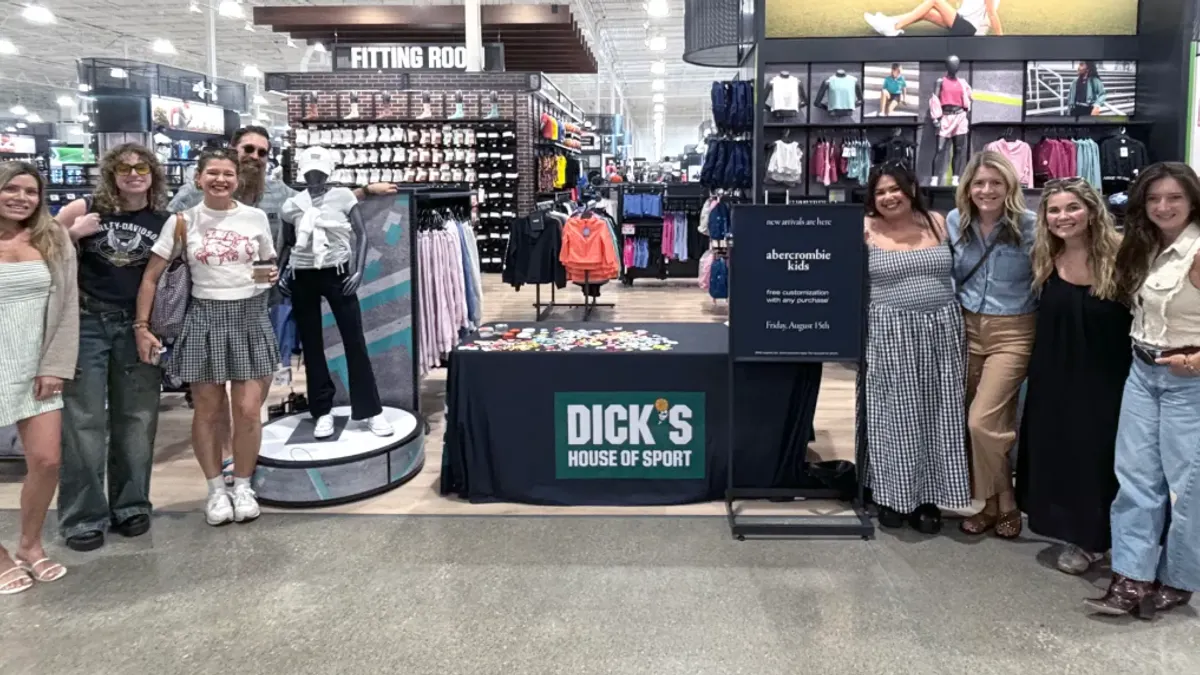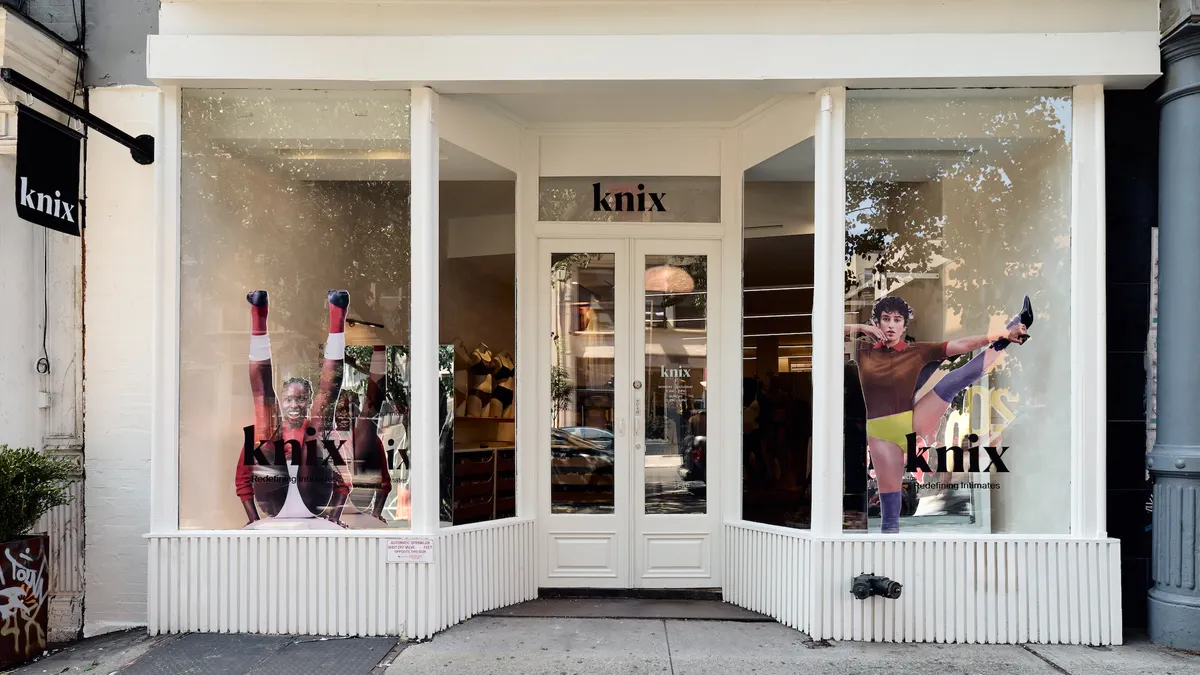Editor’s note: This story is part of a series on the trends that will shape the industry in 2021. You can find all the articles on our trendline.
The pandemic's arrival in March 2020 meant that it didn't make Retail Dive's trends to watch last year, but it completely upended all expectations for the year.
The health crisis was closely followed by the whole industry throughout 2020, courtesy of the havoc it wreaked on retail operations. Stores were forced closed, employees were furloughed or laid off, rent was skipped, supply chains were strained.
Headed into 2021, retailers have survived the immediate triage period, but the pandemic is still very much present and will continue to shape the year ahead. Indeed, the ability of the crisis to cause more problems, or abate them, depending on how the world recovers will perhaps have the largest effect on the industry this year.
The pandemic is a thread weaving through almost every trend the industry faces in 2021, in some cases speeding up inevitable changes many years in the making and in others sparking unexpected developments. Whatever this year brings, the changes driven by the convergence of the pandemic and longstanding industry tailwinds will influence what retailers do and reshape the industry.
Here's what Retail Dive is tracking in 2021.
1. The pandemic will forever alter the brick-and-mortar landscape
The major blow to retailers that came from the pandemic's forced closure of stores last spring lessened somewhat throughout the year as stores reopened, but long-term changes to the retail landscape are inevitable.
Several retailers, whether through bankruptcy or not, sped up or expanded plans to close stores, especially at malls. Companies as diverse as Gap Inc., Macy's, Victoria's Secret and Nordstrom announced plans to close doors permanently, adding up to hundreds of empty locations, many of them mall anchors and specialty tenants or downtown flagships.
Strip centers fared better, and Macy's is among those switching to the format. Analysts also see some hope for neighborhood shopping districts as people continue to work from home and frequent their local shops, and Foot Locker and Nike are among those embracing the idea of community-oriented locations. But the pandemic, despite some help from a financial COVID relief package early in 2020 designed to help keep small businesses afloat, has been especially challenging for many mom and pops.
It's an open question whether downtown shopping corridors will recover, considering that working from home could remain an option for many workers even after the pandemic subsides. What's more certain is that yet more malls are destined to falter, even some at the high end, with the pandemic accelerating what would have been a five- or 10-year trend. The troubles have ushered in an unprecedented level of cooperation between landlords and their retail tenants, which could provide retailers with flexibility to serve customers in their ideal locations, wherever those may be.
2. The culling of weak retailers will continue apace
The COVID-19 pandemic had the effect of consolidating several years worth of e-commerce growth into a matter of months. It also likely had a similar effect on retail bankruptcies. Last year, J.C. Penney, Neiman Marcus, J. Crew — all retailers that might have slogged into 2021 or 2022 — filed for bankruptcy in an effort to restructure. Others such as Stein Mart and Lord & Taylor, which liquidated their physical footprints, might still be standing today if not for the crisis.
Bankruptcies in 2020 hit levels not seen for more than a decade as the pandemic dragged heavily on traffic to stores and forced them to shutter in the spring. As the COVID-19 pandemic continues to weigh on shoppers and the economy, retailers lacking cash, that are heavily indebted, suffering severe and persistent sales declines, or some combination of those things, are vulnerable to bankruptcy or disappearing entirely. No matter how 2021 plays out, you can expect fewer stores and perhaps companies than today as the year begins.
3. The generalist giants will try to consolidate their 2020 gains
Walmart, Amazon, Target and Costco all saw growth last year ranging from very solid to explosive. Each of them got there in different ways and for different reasons, but those companies have a few things in common. They are huge, with vast cash and capital resources to invest in their businesses and capabilities. And all four are generalists to varying degrees, selling everything from basketballs to apparel to milk.
Along with leaning on Amazon's super fast delivery, pandemic-wary shoppers in 2020 flocked to the one-stop big-box sellers like never before. Their broad offerings meant customers could reduce their trips and, with them, their potential virus exposure. That had the effect of accelerating a longstanding trend of consumers ditching specialists for generalists as a matter of convenience and price. Walmart and Target have also made deep investments in their omnichannel capabilities and product offering that were paying off just as the pandemic shifted shopping habits.
The question hanging over the year ahead is whether retail's biggest players can hold on to customers they gained during the pandemic, or, on the flip side, whether smaller specialists can compete against the retail heavies.
4. The distinction between DTC and traditional retailers will continue to blur
Direct-to-consumer brands have grown in popularity over the past decade, but cracks in the model have begun to emerge in recent years. Some so-called DTC darlings have faced company culture issues, while others have revealed just how difficult it can be to reach profitability selling goods almost entirely online.
And while these brands weren't totally immune from the industry-wide disruptions brought on by the pandemic, they fared slightly better as consumers were driven online.
Wayfair and Chewy — two companies that previously struggled to reach profitability under mounting advertising and marketing costs — have posted record results since the start of the pandemic. Wayfair reported two consecutive quarters of profits, the first time the retailer has been in the black since going public in 2014. The home retailer has benefited from both the category seeing a boom in recent months and more consumers shopping online. And Chewy, while not yet profitable, posted "record" net sales in its most recent quarter and grew its net active customers to 17.8 million.
The model is also attractive to more traditional retailers, like Nike and Under Armour, which have touted the benefits of focusing on their direct-to-consumer channels over wholesale to boost profitability.
The distinction between the two — pure-plays and traditional retailers — will further blur in the year ahead as the ways in which DTC brands adopt traditional practices like opening stores and traditional retailers adopt the direct-to-consumer model continue to shake out.
5. Some pandemic pivots may not stick
To retailers during the pandemic, pivoting and making quick changes meant survival. When stores began offering curbside pickup and contactless payments, and turned some locations into online warehouses, the purpose of a store was redefined. But with the rollout of vaccines, some changes might not be here to stay.
The pandemic upended makeup testers and dressing rooms, and when customers return to physical stores, retailers will have to reimagine experiential retail. As demand for contactless fulfillment offerings like buy online, pick up in store surges, retailers will look for ways to make these services more sustainable.
Growth was pushed aside during the early stages of the pandemic when a record number of stores shut down for good and survival became retailers' main priority. 2021 will likely allow retailers more time to focus again on innovation, but still, new tools emerged in the midst of the pandemic as retailers looked to create socially distant experiences, like using augmented reality to test cosmetics, automated checkout tech and group video shopping platforms. Only time will tell which changes are built to last.
6. The e-commerce boom will continue, but so will its challenges
The pandemic spurred the growing share of sales that e-commerce took by historic numbers last year. But as more consumers grew reliant on making purchases online, the number of orders coupled with pandemic-driven employee shortage left retailers and postal services struggling to cope with the demand.
Site crashes, late deliveries and faulty discount codes reflect badly on retailers, leaving customers unsatisfied. In fact, only 15% of consumers in a recent survey were happy with their online shopping experiences, according to Contentsquare. Giving customers richer and more personalized shopping is essential for retailers if they want to rank well on Google in 2021 and keep up with e-commerce giants.
With store closures and social distancing measures that limit store capacity, retailers have no choice but to compete in an already crowded e-commerce space. Many brick-and-mortar stores have already permanently closed doors due to online competitors in addition to problems caused by the pandemic.
Still, e-commerce platforms attracted more groups of customers in 2020 and will potentially continue to do so into 2021. Shopping app downloads, for example, reached 2.8 million on Black Friday — a new single-day record, according to preliminary estimates from Sensor Tower Store Intelligence.
7. Apparel attempts to bounce back (or at least not bleed out more)
Apparel was in trouble before the pandemic. Experts observed in 2019 that it was one of the most distressed segments of retail, and was suffering from the pitfalls of being oversaturated and overstored. That same year, most of the major bankruptcies were filed by companies that mostly or exclusively sold apparel, including Forever 21, Barneys New York, Charlotte Russe and Gymboree.
Then, in 2020, trends that were problematic within the sector accelerated, leaving in their wake additional bankruptcies from department stores that chiefly sold clothing including J.C. Penney and Lord & Taylor, to specialty players such as J. Crew and Ascena filing Chapter 11. To add to the confusion, large swaths of the population were suddenly working from home and staying there because events and travel were canceled. It changed the way they dressed, with people who once reached for suits or dresses suddenly donning athleisure and loungewear.
In short, the segment took a tremendous hit and the immediate future is about recovery. McKinsey & Company's The State of Fashion 2021 report envisions two possible scenarios to get there. The first "earlier recovery" probability states that global fashion sales will decline by 0% to 5% in 2021, and is predicated on successful virus containment and swift economic restoration. The second "later recovery" scenario doesn't have the apparel industry returning to 2019 levels until the fourth quarter of 2023.
That means the possibility of additional specialty retailer bankruptcies or acquisitions. It also points to apparel companies increasingly relying on digital channels to sell products, even as demand is diminished "due to restrained spending power amid unemployment and rising inequality," according to McKinsey.
8. Consumers will be stuck, and that's a problem for retailers
In 2020, as with so many other macro trends, the pandemic worsened the wealth gap.
When Trump took office in 2016, the top 1% of households held more wealth than the middle class, a reversal from before 2010, and only the top 20% have fully recovered from the Great Recession, according to the Brookings Institute. The pressures on the middle class are a problem for the economy as a whole and for retailers in particular — both depend on a consumer with enough disposable income and financial confidence to buy more than they need.
The pandemic strained both. Personal income in November was down $221.8 billion or 1.1%, disposable personal income fell $218 billion or 1.2%, and personal consumption expenditures fell $63.3 billion or 0.4%, according to the most recent estimates from the U.S. Bureau of Economic Analysis. Jobless claims are also "essentially stuck at a painful, inflated level due to the coronavirus surge," according to Robert Frick, corporate economist at Navy Federal Credit Union. Some 10 million jobs disappeared since February last year, and the holiday season was marked by bargain-hunting due to pandemic-related job and income loss, according to GlobalData. The Conference Board recorded a surprise deterioration in consumer confidence last month.
Despite the promise of vaccines and extra savings from being stuck at home, the average consumer has reason to remain on edge this year, mostly because of the ongoing pandemic. "And as long as that surge continues, even with stimulus, we can expect more than 1 million Americans will lose their jobs weekly, based on state and federal measures," Frick said in emailed comments on the last day of 2020.
9. New owners take center stage
2020 brought in a surprising new class of retail owners that ultimately may change the trajectory of business models. Authentic Brands Group, which already owned a handful of apparel brands and licenses and eventually bought Barneys in 2019, teamed up with Simon Property Group again this summer to buy legacy retailer Brooks Brothers and then Lucky Brand. They had previously partnered to buy Forever 21 early in the year and Aeropostale in 2016. Now their 50/50 venture, called Sparc Group, is the operating partner for Aeropostale, Forever 21, Lucky Brand, Brooks Brothers and Nautica.
Real estate companies got further into the mix, effectively turning mall owners into retail business owners. In arguably the biggest play of the year, landlords Simon Property Group and Brookfield Asset Management bought J.C. Penney's department store operations at the close of 2020.
Also on the scene is Retail Ecommerce Ventures, which snapped up the IP of multiple retailers including Modell's Sporting Goods, Dressbarn and Stein Mart.
Although the impact of shifting ownership may not be seen immediately, many questions remain regarding these players. Will brands become divorced from their operations? Are companies that were once household names going to lean into licensing? Are more specialty retailers going to end up selling their IP to conglomerates? And ultimately, how is it all going to impact the shopping experience?





















